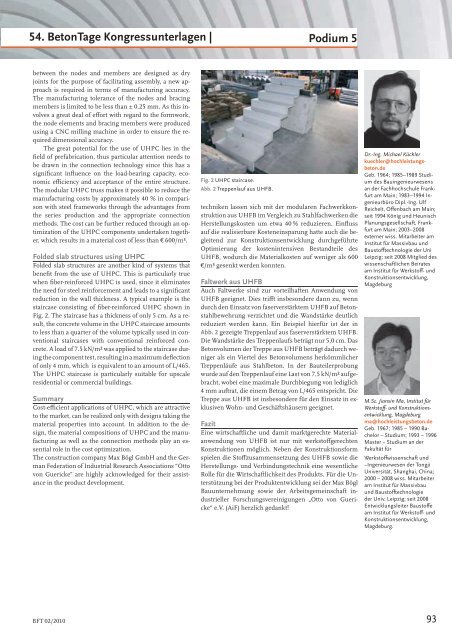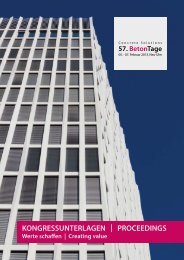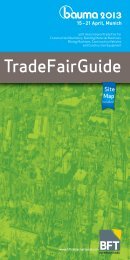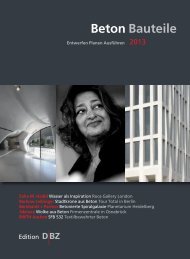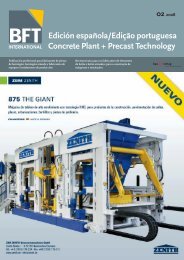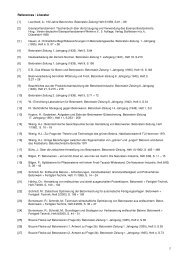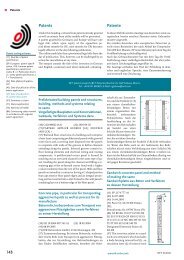Concrete Plant + Precast Technology Betonwerk ... - BFT International
Concrete Plant + Precast Technology Betonwerk ... - BFT International
Concrete Plant + Precast Technology Betonwerk ... - BFT International
Erfolgreiche ePaper selbst erstellen
Machen Sie aus Ihren PDF Publikationen ein blätterbares Flipbook mit unserer einzigartigen Google optimierten e-Paper Software.
54. BetonTage Kongressunterlagen |<br />
between the nodes and members are designed as dry<br />
joints for the purpose of facilitating assembly, a new approach<br />
is required in terms of manufacturing accuracy.<br />
The manufacturing tolerance of the nodes and bracing<br />
members is limited to be less than ± 0.25 mm. As this involves<br />
a great deal of eff ort with regard to the formwork,<br />
the node elements and bracing members were produced<br />
using a CNC milling machine in order to ensure the required<br />
dimensional accuracy.<br />
The great potential for the use of UHPC lies in the<br />
fi eld of prefabrication, thus particular attention needs to<br />
be drawn in the connection technology since this has a<br />
signifi cant infl uence on the load-bearing capacity, economic<br />
effi ciency and acceptance of the entire structure.<br />
The modular UHPC truss makes it possible to reduce the<br />
manufacturing costs by approximately 40 % in comparison<br />
with steel frameworks through the advantages from<br />
the series production and the appropriate connection<br />
methods. The cost can be further reduced through an optimization<br />
of the UHPC components undertaken together,<br />
which results in a material cost of less than € 600/m³.<br />
Folded slab structures using UHPC<br />
Folded slab structures are another kind of systems that<br />
benefi t from the use of UHPC. This is particularly true<br />
when fi ber-reinforced UHPC is used, since it eliminates<br />
the need for steel reinforcement and leads to a signifi cant<br />
reduction in the wall thickness. A typical example is the<br />
staircase consisting of fi ber-reinforced UHPC shown in<br />
Fig. 2. The staircase has a thickness of only 5 cm. As a result,<br />
the concrete volume in the UHPC staircase amounts<br />
to less than a quarter of the volume typically used in conventional<br />
staircases with conventional reinforced concrete.<br />
A load of 7.5 kN/m² was applied to the staircase during<br />
the component test, resulting in a maximum defl ection<br />
of only 4 mm, which is equivalent to an amount of L/465.<br />
The UHPC staircase is particularly suitable for upscale<br />
residential or commercial buildings.<br />
Summary<br />
Cost-effi cient applications of UHPC, which are attractive<br />
to the market, can be realized only with designs taking the<br />
material properties into account. In addition to the design,<br />
the material compositions of UHPC and the manufacturing<br />
as well as the connection methods play an essential<br />
role in the cost optimization.<br />
The construction company Max Bögl GmbH and the German<br />
Federation of Industrial Research Associations “Otto<br />
von Guericke” are highly acknowledged for their assistance<br />
in the product development.<br />
<strong>BFT</strong> 02/2010<br />
Fig. 2 UHPC staircase.<br />
Abb. 2 Treppenlauf aus UHFB.<br />
Podium 5<br />
techniken lassen sich mit der modularen Fachwerkkonstruktion<br />
aus UHFB im Vergleich zu Stahlfachwerken die<br />
Herstellungskosten um etwa 40 % reduzieren. Einfl uss<br />
auf die realisierbare Kosteneinsparung hatte auch die begleitend<br />
zur Konstruktionsentwicklung durchgeführte<br />
Optimierung der kostenintensiven Bestandteile des<br />
UHFB, wodurch die Materialkosten auf weniger als 600<br />
€/m³ gesenkt werden konnten.<br />
Faltwerk aus UHFB<br />
Auch Faltwerke sind zur vorteilhaften Anwendung von<br />
UHFB geeignet. Dies triff t insbesondere dann zu, wenn<br />
durch den Einsatz von faserverstärktem UHFB auf Betonstahlbewehrung<br />
verzichtet und die Wandstärke deutlich<br />
reduziert werden kann. Ein Beispiel hierfür ist der in<br />
Abb. 2 gezeigte Treppenlauf aus faserverstärktem UHFB.<br />
Die Wandstärke des Treppenlaufs beträgt nur 5,0 cm. Das<br />
Betonvolumen der Treppe aus UHFB beträgt dadurch weniger<br />
als ein Viertel des Betonvolumens herkömmlicher<br />
Treppenläufe aus Stahlbeton. In der Bauteilerprobung<br />
wurde auf den Treppenlauf eine Last von 7,5 kN/m² aufgebracht,<br />
wobei eine maximale Durchbiegung von lediglich<br />
4 mm auftrat, die einem Betrag von L/465 entspricht. Die<br />
Treppe aus UHFB ist insbesondere für den Einsatz in exklusiven<br />
Wohn- und Geschäftshäusern geeignet.<br />
Fazit<br />
Eine wirtschaftliche und damit marktgerechte Materialanwendung<br />
von UHFB ist nur mit werkstoff gerechten<br />
Konstruktionen möglich. Neben der Konstruktionsform<br />
spielen die Stoff zusammensetzung des UHFB sowie die<br />
Herstellungs- und Verbindungstechnik eine wesentliche<br />
Rolle für die Wirtschaftlichkeit des Produkts. Für die Unterstützung<br />
bei der Produktentwicklung sei der Max Bögl<br />
Bauunternehmung sowie der Arbeitsgemeinschaft industrieller<br />
Forschungsvereinigungen „Otto von Guericke“<br />
e.V. (AiF) herzlich gedankt!<br />
Dr.-Ing. Michael Küchler<br />
kuechler@hochleistungsbeton.de<br />
Geb. 1964; 1985–1989 Studium<br />
des Bauingenieurwesens<br />
an der Fachhochschule Frankfurt<br />
am Main; 1983–1994 Ingenieurbüro<br />
Dipl.-Ing. Ulf<br />
Reichelt, Off enbach am Main;<br />
seit 1994 König und Heunisch<br />
Planungsgesellschaft, Frankfurt<br />
am Main; 2003–2008<br />
externer wiss. Mitarbeiter am<br />
Institut für Massivbau und<br />
Baustoff technologie der Uni<br />
Leipzig; seit 2008 Mitglied des<br />
wissenschaftlichen Beirates<br />
am Institut für Werkstoff - und<br />
Konstruktionsentwicklung,<br />
Magdeburg<br />
M.Sc. Jianxin Ma, Institut für<br />
Werkstoff - und Konstruktionsentwicklung,<br />
Magdeburg<br />
ma@hochleistungsbeton.de<br />
Geb. 1967; 1985 – 1990 Bachelor<br />
– Studium; 1993 – 1996<br />
Master – Studium an der<br />
Fakultät für<br />
Werkstoff wissenschaft und<br />
–Ingenieurwesen der Tongji<br />
Universität, Shanghai, China;<br />
2000 – 2008 wiss. Mitarbeiter<br />
am Institut für Massivbau<br />
und Baustoff technologie<br />
der Univ. Leipzig; seit 2008<br />
Entwicklungsleiter Baustoff e<br />
am Institut für Werkstoff - und<br />
Konstruktionsentwicklung,<br />
Magdeburg.<br />
93


